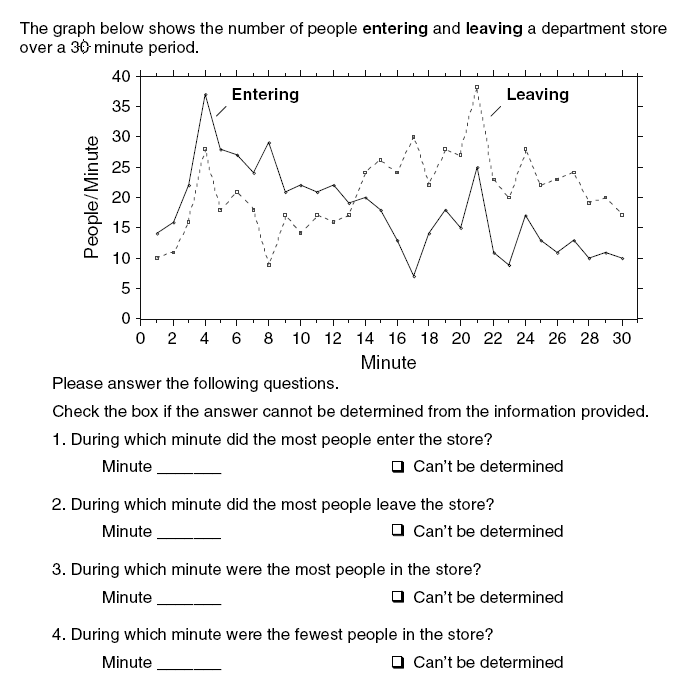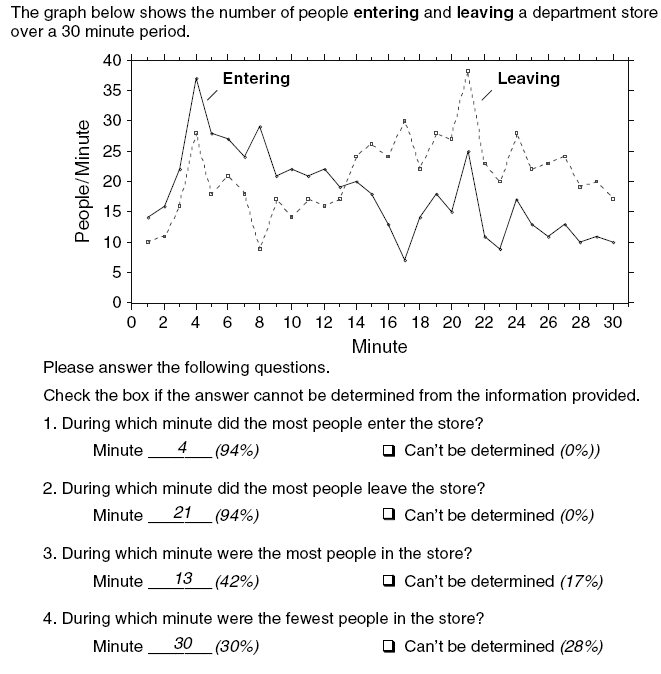
Dynamics

|
Generational Dynamics |
| Forecasting America's Destiny ... and the World's | |
| HOME WEB LOG COUNTRY WIKI COMMENT FORUM DOWNLOADS ABOUT | |
Return to "System Dynamics and the failure of macroeconomics theory" page
This is a very simple System Dynamics problem in a simple situation -- a few people enter and leave a store. It requires no math, and nothing more than a little intuition. It's taken from All Models are Wrong: Reflections on Becoming a Systems Scientist, written by Prof. John Sterman, director of the MIT System Dynamics Group.
Just to make it a little easier, we'll explain the graph below: In the first minute, 10 people leave the store, and 14 people enter; in the second minute, 11 people leave and 16 people enter.
 |
Scroll down a few inches to see the hint, and a few more inches to see the solution.
If you're completely stumped, here's something you can try:
Scroll down a few inches to see the hint, and a few more inches to see how to solve the problem directly from the graph, without having to set up the table described by this hint.
 |
Even though this is a simple test in a simple situation, very few people get all four questions right, or even grasp how to solve the problems. Here are the solutions:
The number of people entering the store each minute is shown by the solid line graph, which peaks at minute 4.
The number of people leaving the store each minute is shown by the dotted line graph, which peaks at minute 21.
During the first thirteen minutes, the solid line graph (number of people entering) is above the dotted line graph (number of people leaving), and so more and more people entered the store during that period. After minute 13, more people are leaving than entering, so after minute 13 the number of people in the store goes down. So the most people are in the store at minute 13.
The number of people in the store goes up until minute 13, and down until minute 30. So there are two possible answers: Minute 0 (the beginning) or minute 30 (the end).
Prof. Sterman gives the answer: "To determine which, you must judge whether more people enter up to minute 13 than leave afterwards, that is, whether the area between the rate of entering and rate of leaving up to minute 13 is greater or smaller than the area between the two curves from minute 14 on. Inspection of the graph readily reveals that the area between the curves from minute 14 on is larger than the area between the curves through minute 13 (in fact it is twice as large). More people left after minute 13 than were added up to that point. The fewest people are therefore in the store at minute 30."
In terms of System Dynamics, "stocks and flows" refers to the people in the store. When someone enters the store, then the stock of people in the store increases -- that's called "inward flow" or "inflow." Conversely, when someone leaves the store -- and that's "outward flow" or "outflow" -- then the stock of people in the store decreases,
If you're still stumped, then go back to the hint, earlier on this page, and do it that way by drawing the 31-line table. That should help.
Return to "System Dynamics and the failure of macroeconomics theory" page